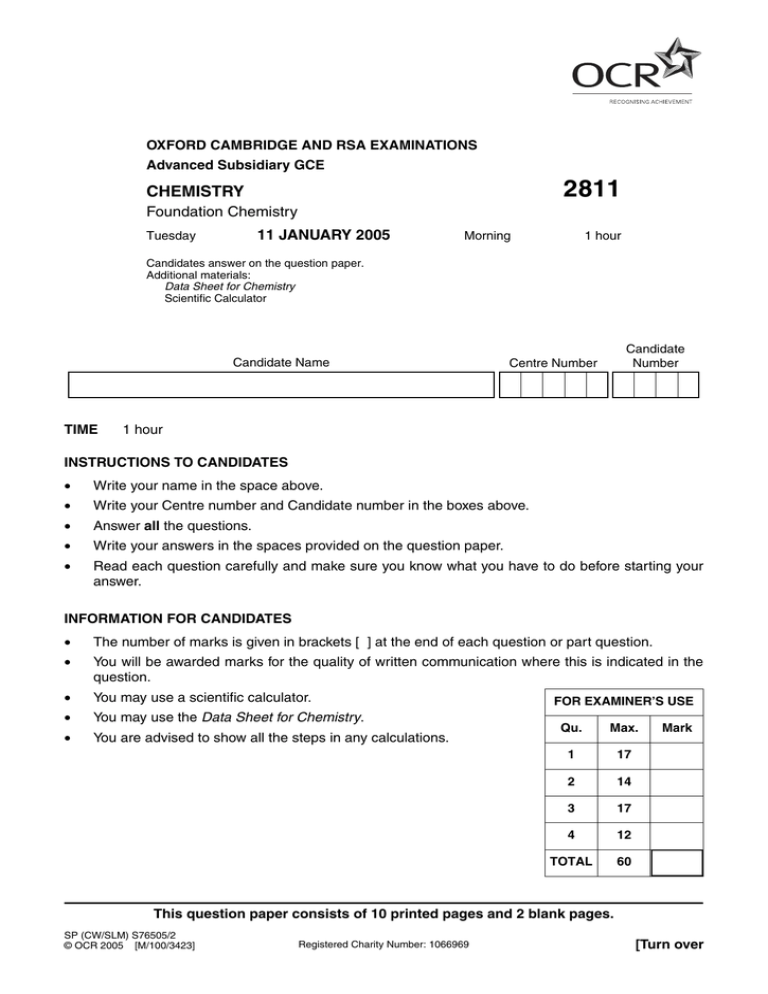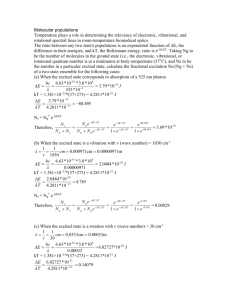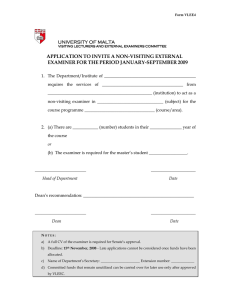chemistry - The Student Room
advertisement

OXFORD CAMBRIDGE AND RSA EXAMINATIONS Advanced Subsidiary GCE 2811 CHEMISTRY Foundation Chemistry 11 JANUARY 2005 Tuesday Morning 1 hour Candidates answer on the question paper. Additional materials: Data Sheet for Chemistry Scientific Calculator Candidate Name TIME Candidate Number Centre Number 1 hour INSTRUCTIONS TO CANDIDATES • Write your name in the space above. • Write your Centre number and Candidate number in the boxes above. • Answer all the questions. • Write your answers in the spaces provided on the question paper. • Read each question carefully and make sure you know what you have to do before starting your answer. INFORMATION FOR CANDIDATES • The number of marks is given in brackets [ ] at the end of each question or part question. • You will be awarded marks for the quality of written communication where this is indicated in the question. • You may use a scientific calculator. • You may use the Data Sheet for Chemistry. • You are advised to show all the steps in any calculations. FOR EXAMINER’S USE Qu. Max. 1 17 2 14 3 17 4 12 TOTAL 60 Mark This question paper consists of 10 printed pages and 2 blank pages. SP (CW/SLM) S76505/2 © OCR 2005 [M/100/3423] Registered Charity Number: 1066969 [Turn over For Examiner’s Use 2 Answer all the questions. 1 Carbon is in the p-block of the Periodic Table. Naturally occurring carbon contains a mixture of two isotopes, 12C and 13C. (a) Complete the table below for the atomic structure of the isotopes 12C and 13C. isotope protons neutrons electrons 12C 13C [2] (b) A sample of carbon was found to contain 95% of 12C and 5% of 13C. (i) How could this information be obtained experimentally? ...............................................................................................................................[1] (ii) The 13C isotope has a relative isotopic mass of 13.00. Define the term relative isotopic mass. ................................................................................................................................... ................................................................................................................................... ...............................................................................................................................[2] (iii) Calculate the relative atomic mass of this sample of carbon to three significant figures. Ar = ................... [2] (c) Complete the electronic configuration of carbon. 1s2 ................................................................................................................................[1] (d) The burning of fossil fuels containing carbon produces carbon dioxide. Draw a ‘dot-and-cross’ diagram of carbon dioxide, showing outer shell electrons only. [2] 2811 Jan05 For Examiner’s Use 3 (e) Lime water is used as the common laboratory test for carbon dioxide. (i) State the name or formula of the chemical that is dissolved in water to make lime water. ...............................................................................................................................[1] (ii) Write the chemical equation that takes place in this test for carbon dioxide. Include state symbols. ...............................................................................................................................[2] (f) Carbon dioxide can be prepared easily in the laboratory by the action of heat on most carbonates. Construct an equation to illustrate this reaction. ......................................................................................................................................[1] (g) In 2000, the mass of CO2 emitted in the UK was equivalent to 1 kg per person in every hour. (i) Calculate the volume of 1 kg of carbon dioxide. Assume that 1 mole of CO2 occupies 24 dm3. volume = ................... dm3 [2] (ii) The UK has set a target to cut CO2 emissions by 60% of the 2000 value by 2050. Calculate the reduction needed in the volume of CO2 emissions each hour per person if the target is to be met. answer: ................... dm3 [1] [Total: 17] 2811 Jan05 [Turn over 4 2 A student prepared an aqueous solution of calcium chloride by reacting calcium with hydrochloric acid. Calcium chloride contains Ca2+ and Cl– ions. (a) Complete and balance the following equation for this reaction. ……Ca(s) + ……HCl(aq) → …….CaCl2(aq) + ………… [2] (b) This is a redox reaction. Use oxidation states to show that calcium has been oxidised. .......................................................................................................................................... .......................................................................................................................................... ......................................................................................................................................[2] (c) Draw a ‘dot-and-cross’ diagram for CaCl2. [2] (d) Aqueous silver nitrate was added to the solution of CaCl2. (i) State what you would expect to see. ................................................................................................................................... ...............................................................................................................................[1] (ii) Write an ionic equation for this reaction. ...............................................................................................................................[1] 2811 Jan05 For Examiner’s Use 5 (e) To prepare the aqueous calcium chloride, the student added the exact amount of calcium so that all the hydrochloric acid had reacted. She used 50 cm3 of 2.0 mol dm–3 HCl. (i) For Examiner’s Use How many moles of HCl had she used? [1] (ii) Calculate the mass of calcium that she used. [2] (iii) The student added some more calcium and she was surprised that a reaction still took place. • Explain this observation. • Write a balanced equation for this reaction. ................................................................................................................................... ................................................................................................................................... ................................................................................................................................... ...............................................................................................................................[3] [Total: 14] 2811 Jan05 [Turn over For Examiner’s Use 6 3 This question refers to the elements in the first three periods of the Periodic Table: H He Li Be B C N O F Ne Na Mg Al Si P S Cl Ar (a) Identify an element from the first three periods that fits each of the following descriptions. (i) The element that forms a 2– ion with the same electronic configuration as Ne. ................... (ii) [1] The element that forms a 3+ ion with the same electronic configuration as Ne. ................... (iii) [1] The element that has the electronic configuration 1s22s22p63s23p3. ................... (iv) [1] An element that forms a compound with hydrogen with tetrahedral molecules. ................... (v) [1] An element that forms a compound with hydrogen with pyramidal molecules. ................... (vi) [1] The element that forms a chloride XCl2 with a molar mass of 95.3 g mol–1. ................... (vii) [1] The element with the largest atomic radius. ................... (viii) [1] The element in Period 3 with the highest boiling point. ................... [1] 2811 Jan05 7 (b) The diagram below shows the variation in the first ionisation energies of elements across Period 2 of the Periodic Table. For Examiner’s Use A diagram has been removed due to third party copyright restrictions Details: A diagram showing the variation in the first ionisation energies of elements across Period 2 of the Periodic Table (i) Define the term first ionisation energy . ................................................................................................................................... ................................................................................................................................... ...............................................................................................................................[3] (ii) Explain why the first ionisation energies show a general increase across Period 2. ................................................................................................................................... ................................................................................................................................... ...............................................................................................................................[2] (iii) Explain why the first ionisation energy of B is less than that of Be. ................................................................................................................................... ................................................................................................................................... ...............................................................................................................................[2] (iv) Estimate a value for the first ionisation energy of the element with atomic number 11. Explain how you made your choice. First ionisation energy = .................. kJ mol –1 ................................................................................................................................... ................................................................................................................................... ...............................................................................................................................[2] [Total: 17] 2811 Jan05 [Turn over 8 4 In this question, one mark is available for the quality of spelling, punctuation and grammar. The halogens chlorine, bromine and iodine each exist as diatomic molecules at room temperature and pressure. (a) The halogens all have van der Waals’ forces. • Explain how van der Waals’ forces are formed. • Explain the trend in volatilities of the halogens chlorine, bromine and iodine. .......................................................................................................................................... .......................................................................................................................................... .......................................................................................................................................... .......................................................................................................................................... .......................................................................................................................................... .......................................................................................................................................... .......................................................................................................................................... .......................................................................................................................................... .......................................................................................................................................... .......................................................................................................................................... .......................................................................................................................................... .......................................................................................................................................... .......................................................................................................................................... .......................................................................................................................................... .......................................................................................................................................... .......................................................................................................................................... .......................................................................................................................................... .......................................................................................................................................... .......................................................................................................................................... .......................................................................................................................................... .......................................................................................................................................... .......................................................................................................................................... ......................................................................................................................................[6] 2811 Jan05 For Examiner’s Use 9 (b) Describe and explain the relative reactivity of the halogens chlorine, bromine and iodine in displacement reactions involving halides, using reactions on a test tube scale. Include equations and observations in your answer. .......................................................................................................................................... .......................................................................................................................................... .......................................................................................................................................... .......................................................................................................................................... .......................................................................................................................................... .......................................................................................................................................... .......................................................................................................................................... .......................................................................................................................................... .......................................................................................................................................... .......................................................................................................................................... .......................................................................................................................................... .......................................................................................................................................... .......................................................................................................................................... .......................................................................................................................................... .......................................................................................................................................... .......................................................................................................................................... .......................................................................................................................................... .......................................................................................................................................... .......................................................................................................................................... .......................................................................................................................................... .......................................................................................................................................... ......................................................................................................................................[5] Quality of Written Communication [1] [Total: 12] END OF QUESTION PAPER 2811 Jan05 For Examiner’s Use 10 BLANK PAGE 2811 Jan05 11 BLANK PAGE 2811 Jan05 12 Permission to reproduce items where third-party owned material protected by copyright is included has been sought and cleared where possible. Every reasonable effort has been made by the publisher (OCR) to trace copyright holders, but if any items requiring clearance have unwittingly been included, the publisher will be pleased to make amends at the earliest possible opportunity. OCR is part of the Cambridge Assessment Group. Cambridge Assessment is the brand name of University of Cambridge Local Examinations Syndicate (UCLES), which is itself a department of the University of Cambridge. 2811 Jan05


